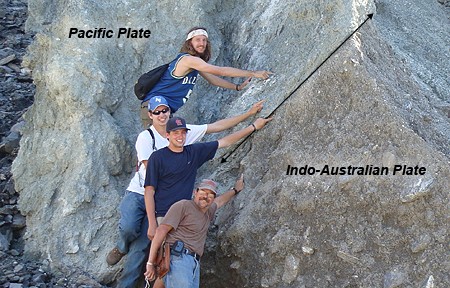 DePauw University took a group of students on a tour of New Zealand's geological highlights during Winter Term 2010. Leading the tour were Associate Professor of Geosciences Tim D. Cope and Professor of Geociences James G. Mills.
DePauw University took a group of students on a tour of New Zealand's geological highlights during Winter Term 2010. Leading the tour were Associate Professor of Geosciences Tim D. Cope and Professor of Geociences James G. Mills.New Zealand is home to one of the broadest collections of geological features on the planet, all packed densely across an area the size of Colorado, reports the DePauw news bureau. Beneath the North Island, the Pacific tectonic plate is being forced under the Indo-Australian plate, forming a chain of volcanoes where molten rock reaches the surface above. This sort of volcanic activity can occur on land or underwater depending on where the plates meet.
On the South Island, the Pacific and Indo-Australian plates collide, pushing the Southern Alps nearly four kilometers high at a geologic pace of 1.1 centimeters per year. Because of the different type of tectonic convergence on the South Island, it's possible to place a hand on outcroppings of both massive plates at the same time (pictured above). Cope argues that being able to touch and walk among the lessons taught in the classroom is a key part of an education in geology.
The group also took a day trip to White Island, an active marine volcano off the North Island's coast, named for the cloud of steam that rises from it. White Island erupted as recently as July 2000.
"It made a huge difference to be able to actually see and touch the geologic features that we learned about in class," reported DePauw student Christina M. Wildt. "I thought I understood everything that I learned in our Earth and the Environment course, but I realized after I was in New Zealand that you can't really understand geology fully unless you experience it in the field."
.

No comments:
Post a Comment